You can’t talk about course cutting at a triathlon without mentioning Julie Miller. Miller was famously busted for cutting short the run portion of Ironman Canada. Other results were looked at with skepticism and more disqualifications followed. At Ironman Canada, Miller ditched her timing chip near the beginning of her run and only completed one lap of the two lap course.
Last week, I received a tip from #brutallyhonestaf and complaints from others regarding another Canadian Athlete. Her time seemed unlikely, and, like Julie Miller, her timing chip went missing. What followed was an attempted cover-up and then an admission that raised more questions than it gave answers.
IRONMAN 70.3 St. George, Utah
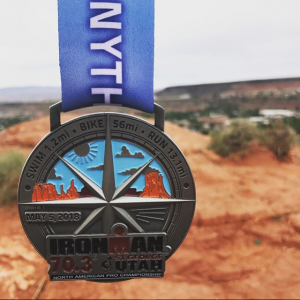
Amanda finished the swim and the bike without issue. She was picked up out of the bike transition and registered a time of 36:52 at the 2.3-mile run split (16:06 per mile split). Her chip did not register again.
Her time raised some suspicion and put her on the radar among competitors and teammates both because of the missing tracking and because of her run time. After the first split registered at 16:06 minutes per mile, she ran the remainder of the race at a 10:18 minute/mile pace. Her total pace for the run was 11:19 minutes per mile. Her typical time for the last leg of a 70.3 is closer to 2:30:00. She stated that this time qualified her for 70.3 Worlds, which she declined.
IRONMAN Mont-Tremblant
On Instagram she stated,
“Left it all out on the course today. hit the target for my swim, struggled on the bike due to a plethora of issues (mainly mechanical) and tried to make up some time by laying it out on the run. 13:26:19 pour moi and lots of happy tears. Tracker fell off during the bike course so you’ll have to catch the finish line live stream instead.”
On Sportstats, Amanda showed a finish time of 16:51:30, but finish line video shows she crossed the finish with a total time of 13:25:53. I confirmed this by determining the Time of Day Finish based on the runners that finished immediately before and after her. This approximate finish time was also confirmed in conversations with officials at Sportstats.

The determination was made that the chip was recovered at some point, and her finish time on the Sportstats site was when the chip was picked up after being carried near the finish by the person that recovered it.
Her Strava account for the race was comprised of manual entries.
1 hr 20 minutes for the swim
7 hr 38 minutes for the bike.
4 hr 15 minutes for the marathon.
The run time seemed very unlikely. Amanda typically runs standalone half marathons in the 2-1/2 hour range and has a stand alone marathon P.R. of 4:49:53 based on her Athlinks results.
After my initial investigation, I forwarded the information to Sportstats. They agreed with my assessment that Amanda did not complete the full course legitimately.
At this point, I reached out to Amanda.
The Cover Up
I asked Amanda for GPS files for both St. George and Mont-Tremblant. She explained that she no longer had GPS data from St. George but was adamant that St. George was previously resolved. She provided the below screenshot as evidence of completing Mont-Tremblant.

I knew immediately that this was a manual entry. This entry had no map and was missing the last tab as shown on my legitimate run entry from the Heart Mini Marathon in Cincinnati. (Yes, I was slow.)
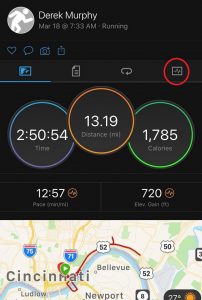
I was able to replicate Amanda’s entry within a few minutes.

Knowing what I was looking at, I asked for splits. About 16 hours later, she sent me the below screenshots.
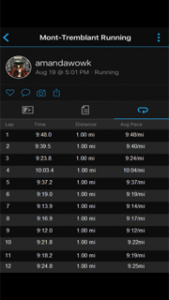
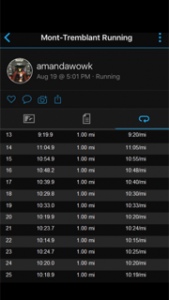
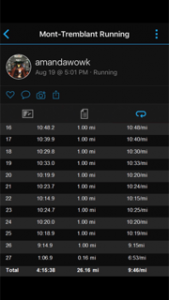
I was surprised that I received any splits, but I knew these were not legitimate. If you add up the individual splits, they do not equal the total time provided.
After I contacted Sportstats, Ironman was asked that Amanda provide her GPS data or face disqualification. I learned that she also submitted these falsified entries to Ironman.
Throughout this time, I had asked for actual GPS files, but, at the time, she said that she didn’t share her GPS files due to privacy concerns.
After receiving these splits, I let Amanda know that I was aware that she sent me faked data. A short time later, she emailed me back and asked me to give her a call.
Admission of Guilt – and More Questions
I spoke to Amanda on Sunday afternoon. She did apologize for falsifying the data and admitted to cutting the run portion at Mont-Tremblant.
“I did not complete the entire run. I wanted to, I struggled.”
Amanda says she was dealing with an injury, but it had been manageable. She took a prescribed painkiller and said she had a reaction to the medication, and she tried to take Advil, and it did nothing to help.
Instead of going to the medic, she says she started panicking thinking she’d be labeled as an athlete trying to “screw around with banned substances”. She said her thought process was that she’d be tested if she went to the medic. She referenced a recent article about age groupers being tested as a source of her concern.
Amanda was adamant that what happened at Mont-Tremblant had nothing to do with time, but everything to do with her injury. Amanda says that she completed a single loop of the 2-loop course.
In regards to the run, while it was now largely irrelevant, based on the Sportstats data, her run time would have been 3:43:42. This was calculated based on when her chip crossed the start of the run. Amanda did provide evidence of when she exited the bike transition without her chip. The time on Sportstats evidently was showing her chip crossing the timing mats after someone recovered it.
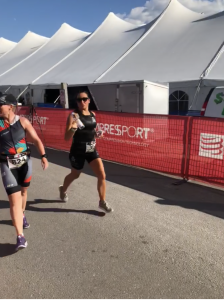
Amanda is on the right. It is clear that she is not wearing the timing chip. By using the runner’s time, we are able to get a better estimate of Amanda’s run time. It is more in line with her manual times she posted on Strava.
However, this evidence is not at all helpful to Amanda:
Here are the relevant split times: Up until 162km, Amanda was averaging a little over 20km/hr. This is consistent with other races.
162 km – 4:33:44 PM
170.8 km – missed split.
180 km – 4:50:13 estimating 9:47 transition.
If this is believed, she would have covered 18 km in 16:29 – a pace of 65 km/hr.
On our phone conversation, she referenced wasting time at the transition trying to obtain a chip. However, in an email on Monday, she said she blew right through the transition and estimated the transition took her a total of 3 minutes.
Giving her the benefit of the doubt, if she only spent 3 minutes in transition, it would still mean she raced the last 18 km at a greater than 50 km/hr pace.
The top overall male biked this section in over 28 minutes. The scenarios below show that if Amanda biked this section legitimately, she was faster than the top male by at least 4 minutes and by as much as 11 minutes.
It is my opinion that she cut the last loop of the bike after previously discarding (or losing) her chip. The experts at Sportstats independently came to the same conclusion.
“SHE DID CUT THE BIKE COURSE, 100%”
Again, Amanda is adamant that she did not cut the bike course. She also concedes that she would not have ridden at the calculated paces, so she stated that it is her belief that the timing data is incorrect.
I felt it was important to try to get the whole picture of what happened. While her reasoning of why she didn’t simply drop out did not seem logical to me, I felt it was important to try to validate the timing of the events on the course.
Aftermath
Amanda still stands by her St. George time. She says that her chip malfunctioned, and she gave it to an official before the finish. Initially, Ironman and Sportstats took her at her word and assumed the chip was defective. However after I brought the concerns to their attention, they determined that this chip has never been recovered, which is inconsistent with Amanda’s story of giving the chip to an official.
As I am writing this, Amanda has been disqualified from both Mont-Tremblant and St. George. It is unknown if there will be any bans levied by Ironman, USAT, or Triathlon Canada. For reference, Julie Miller was banned for two years by Triathlon Canada, and she was indefinitely banned by Ironman. Julie had actually claimed victories; Amanda has not placed in her age group.
Amanda competes in a lot of races. At one point, she was the fourth-ranked Canadian women in the “All World Athlete Rankings.” Participants earn points based on their finishing placements at Ironman events to qualify for the different levels of “All World Athlete.” With the disqualifications, she will likely drop out of the rankings.
Amanda was a member of the TriMafia team. They acted quickly to remove her from the team when they were notified of her admission to cutting the course at Mont-Tremblant.
Support Marathon Investigation
To support Marathon Investigation, consider making a small contribution. Contributions go towards costs associated with running the site and costs associated with investigations.
Don’t want to use Paypal? Click below to contribute without going through Paypal.



The funny thing is she would have no clue if the chip was malfunctioning before the finish line. Ironman chips have 0 indicator as to if they’re working properly to the individual wearing them. For her to say she knew that, took it off, and gave it to an office is just a pure lie. She’s just grasping at straws. Great article!
Spot on, NRB. Actually, I don’t know of ANY chip systems that give feedback to individual users. All a chip has is an antenna, rectifier, and transmitter, and only sends the chip ID back to the pad. I’m not a tri (and, at 64, losing ground for a viable “Round Tuit”), but I’ve used a local multisport timing company’s Velcro ankle strap device, and had no issue; held on pretty tightly, and a veteran (tri)athlete should be acutely aware of ensuring any timing chip is secure. I imagine swimming would be the worst, what with all the leg thrashing. One of her initial claims was losing it during bike leg. I dunno; I’m sure it COULD, and maybe HAS, happened, but it seems the only time we hear of “lost chip” is when the evidence points to cheating.
Big Wick, some chip systems have a “chirp” when you cross the mat. Assuming that this race had that, and she hit the mat by herself, she could have figured out that she had a bad chip. Also, some races have a display board when you cross the mat, so you can see your name/number. I don’t race tri either, so I am basing this on trail races that I have done.
Interesting thing on technology failures, I did a race with a SPOT (GPS) tracker and it failed during the race (showed me stopped at the first aid station for the entire race). It wasn’t an issue, I DNF’d for another reason; just wanted to point out that technology does fail. Also, not saying that a tech failure was an issue her, seems more like a moral failure.
I’ve done Saint George ironman 6 times and yes it chirps at you when you cross the timing mats. No display board though.
well, the only clue any racer would have of a timing chip malfunction would be no sound when crossing a timing mat. Of the races I can recall, when I cross a timing mat the timing device normally beeps. There’s a possibility the hers didn’t and if a timing official was there watching, he/she might alert the athlete.
Having said that, it seems unlikely her chip wasn’t working and most athletes, I think, would not be too concerned with removing a malfunctioning chip.
First of, thanks for the awesome piece of investigative journalism Derek!
NRB if you are super saavy at timing mats, you’ll notice to things potentially happen when you cross the line…a beeping sound, and potentially a light flashing on the wireless receiver.
I cannot say this happens at all races, but in most of you are paying attention to the system, rather than racing you may notice it (as a risk aversive engineer, I do because I don’t trust anything)
In the races, it can be impossible to notice both effects of you are clumped with other racers, but if you intentionally isolate yourself you can achieve that goal (I don’t).
You have no way to know that they tied that event to you, other than the fact that they make you personally do a check pre race with the chip to validate who has which chip.
If you are really insane, you could carry around your cell phone and live track yourself out have a loved one do so.
Good article. Same type of patterns of initial denial, “I dug deep for this one” type of statements on social media etc…..then get caught…. followed by denial, absurd excuses, then capitulation with qualifiers usually mentioned to exact some sympathy (injury, tough life situation..). And the usual insistence/denial of another cheating instance that they claim was real (“I know I cheated race abc with xyz excuses but my other marathon was legit – despite overwhelming evidence to the contrary”) – – like saying I cheated but I really didn’t need to, so it was ok under the adverse circumstances.
Greek Tragedy
(ɡriːk ˈtrædʒədɪ)
noun
(in ancient Greek theatre) a play in which the protagonist, usually a person of importance and outstanding personal qualities, falls to disaster through the combination of a personal failing and circumstances with which he or she cannot deal.
Collins English Dictionary. Copyright © HarperCollins Publishers
If these are Greek Tragedies that makes us the chorus.
Hey Derek,
Great article, love your work.
It never ceases to amaze me how these cheaters try to justify their actions.
The only feedback I would have for you to consider…based on your wording “another Canadian athlete” its like you are painting all Canadian athletes with one brush. I don’t see the relevance of mentioning Julie Miller in this article – Amanda has nothing to do with Julie Miller. When you write other articles I don’t see reverencing other athletes as comparison just because of a similar nationality. Full disclosure, I am Canadian myself – we aren’t all cheaters!
The method of cheating was the same as with Julie. The first comments from the timers were to think of Julie. I did not intend to paint all Canadian athletes as cheaters.
I kinda felt the same way. I don’t think you’d use “American” that way. Perhaps we Canadians are more sensitive, too, due to our politeness. Sorry.
In a somewhat ironic twist I was volunteering at the finish line and probably gave her the medal as i was handing them out at that time. Makes me wonder how many cheaters I gave medals to as friends who were racing say they saw multiple people cutting the course.
At Saint George? I guess there is a few places you could cut course. You could not do the several out and backs up on the parkway. Also you could head for the finish line once you hit the top of the hill but that one might be really obvious. The bike also has an out back in Ivins you could cut (I wasn’t going to cut it but I did seriously consider riding off course for half a mile to hit the aid station before doing the out and back as I was dying of thirst).
No, Mt Tremblant.